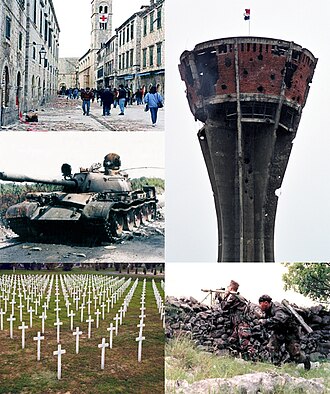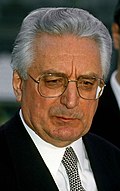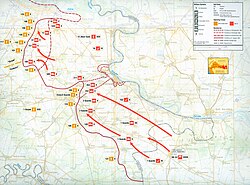Croatian War of Independence
The Croatian War of Independence was fought from 1991 to 1995 between Croat forces loyal to the government of Croatia—which had declared independence from the Socialist Federal Republic of Yugoslavia (SFRY)—and the Serb-controlled Yugoslav People's Army (JNA) and local Serb forces.
| Croatian War of Independence | |||||||||
|---|---|---|---|---|---|---|---|---|---|
| Part of the Yugoslav Wars | |||||||||
 Clockwise from top left: the central street of Dubrovnik, the Stradun, in ruins during the Siege of Dubrovnik; the damaged Vukovar water tower, a symbol of the early conflict, flying the Flag of Croatia; soldiers of the Croatian Army preparing to destroy a Serbian tank; the Vukovar Memorial Cemetery; a Serbian T-55 tank destroyed on the road to Drniš | |||||||||
| |||||||||
| Belligerents | |||||||||
|
1991–94: |
1991–92: | ||||||||
|
1994–95: |
1992–95: | ||||||||
| Commanders and leaders | |||||||||
|
|
| ||||||||
| Strength | |||||||||
|
|
| ||||||||
| Casualties and losses | |||||||||
|
8,685 soldiers and 6,322 civilians killed or missing[4] 300,000 displaced[5] |
4,484 soldiers and 2,650 civilians killed or missing 3,486 soldiers, 2,677 civilians and 864 unidentified killed or missing 300,000 displaced | ||||||||
In Croatia, the war is known as the "Homeland War" (Croatian: [Domovinski rat] Error: {{Lang}}: text has italic markup (help)) and also as the "Greater-Serbian Aggression".
In Serbian sources, "War in Croatia" and (rarely) "War in Krajina" are used.[6]
Croatian War Of Independence Media
Serbian President Slobodan Milošević advocated the incorporation of Serb-claimed lands in Croatia within a common state with Serbia.
Croatian President Franjo Tuđman advocated Croatia to become independent from Yugoslavia.
Map of the strategic offensive plan of the Yugoslav People's Army (JNA) in 1991 as interpreted by the US Central Intelligence Agency
The Croatian military eased their equipment shortage by seizing the JNA barracks in the Battle of the Barracks.
A monument to Josip Jović, widely perceived in Croatia as the first Croatian victim of the war, who died during the Plitvice Lakes incident
Photos of the victims of the Lovas massacre
A destroyed T-34-85 tank in Karlovac, 1992
Croatian soldiers capture a Serb cannon and truck in the Miljevci plateau incident, June 21, 1992
Notes
- ↑ As determined by the Badinter Arbitration Committee, SFR Yugoslavia dissolved during the war. On 25 June 1991, the Croatian parliament declared the independence of Croatia, following a referendum held in May. The decision was suspended for three months; the declaration became effective on 8 October 1991, and Croatia was no longer part of Yugoslavia.
- ↑ Bosnia and Herzegovina was particularly significant for the war in late 1994 and in 1995. Pursuant to the Washington Agreement, the Federation of Bosnia and Herzegovina was formed as a subunit of the Republic of Bosnia and Herzegovina (RBiH) representing both Bosnian Croat and Bosniak (Bosnian Muslim) ethnic groups. Most significantly, the Washington Agreement specifically permitted Croatian Army to enter Bosnia and Herzegovina, thereby allowing operations Cincar and Winter '94 against the army of Republika Srpska, outflanking the RSK capital at Knin and creating a new strategic situation before the decisive battles of the war.
- ↑ There was no formal declaration of war. The first armed clash of the war was the Pakrac clash on 1 March 1991, followed by the Plitvice Lakes incident on 31 March 1991, when the first fatalities occurred. The last major combat operation was Operation Storm, from 5–8 August 1995. Formally, hostilities ceased when the Erdut Agreement was signed on 12 November 1995.
- ↑ There were also some conflicts in Bosnia and Herzegovina, particularly in late 1994 and early 1995. Among those, the most significant to the course of the war were Cincar, and Operation Winter '94.
- ↑ Three months after the military defeat of the RSK in Operation Storm, the UN-sponsored Erdut Agreement between the Croatian and RSK authorities was signed on 12 November 1995. The agreement provided for a two-year transitional period, later extended by a year, during which the remaining occupied territory of Croatia was to be transferred to control of the Croatian government. The agreement was implemented by UNTAES and successfully completed by 1998.
References
- ↑ Peter Maass (16 July 1992). Serb Artillery Hits Refugees – At Least 8 Die As Shells Hit Packed Stadium. http://community.seattletimes.nwsource.com/archive/?date=19920716&slug=1502415. Retrieved 23 December 2010.
- ↑ Tus: U listopadu '91. HV je imao 70.000 vojnika[dead link] Domovinski rat.hr
- ↑ "Centar domovinskog rata - 1995". Archived from the original on November 19, 2012. Retrieved July 17, 2012.
- ↑ Zebić, Enis (15 January 2018). "Ljudski gubici u ratu u Hrvatskoj: 22.211 osoba" (in Croatian). Radio Free Europe. https://www.slobodnaevropa.org/a/hrvatska-ljutski-gubici/28976312.html. Retrieved 17 December 2019.
- ↑ Phuong 2005, p. 157.
- ↑ "Srbija-Hrvatska, temelj stabilnosti" [Serbia-Croatia, foundation of stability] (in Serbian). B92. 4 November 2010. Archived from the original on November 8, 2010. Retrieved 22 December 2010.
{{cite web}}: CS1 maint: unrecognized language (link)









